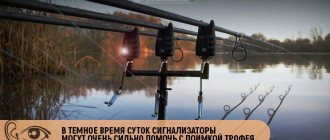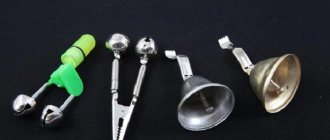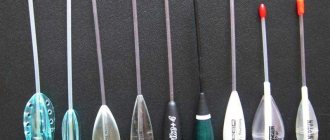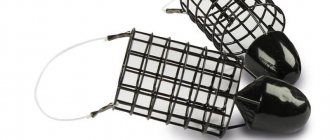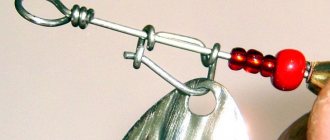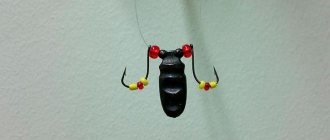The simplest bite alarms (principles of operation, manufacturing instructions):
Every fisherman has eyes, ears and hands to determine the bite. The mechanical signaling device is designed, due to its operating principle, to indicate the beginning of a bite through visual, acoustic or tactile contact.
Mechanical visual alarms
Nod. The simplest devices are the familiar float or the tip of a fishing rod (nod).
These types of alarms are familiar to everyone. Every fisherman knows how to make a float and nod himself, or which one to buy. Foil tube. Also, there are slightly different alarms, which are based on the principle of operation on the vibration of the fishing line. The simplest visual one is a foil tube.
- Take aluminum foil and roll it into a tube.
- Then we put the tube on the main fishing line.
- You need to thread the line between the reel and the first ring on the rod - the line will sag in this place.
As the bite begins, the sag of the line decreases, we understand that the fish has begun to grab the bait. Aluminum foil is good because it shimmers in the sun (its movement is clearly visible), and also rustles when bouncing.
Disadvantage - it is useless in windy conditions (reason is the lightness of the material).
DIY side bite alarm for feeder
The side beacon is a device identical to the nod. Its main components:
- metal or plastic elements;
- similar method of attachment to the feeder;
- installation between the first ring and the coil.
The length of the working part of the side alarm is 100-150 mm, and opposite the feeder there is a hook into which the fishing line is placed after casting.
The mounting angle of the alarm is 90 degrees relative to the feeder form. When the line is pulled, it lies parallel to the feeder. To make a side signaling device, you will need the following parts:
- metal tube , length 50 mm and cross section 3 mm;
- spring wire about 200 mm long;
- is bent from one edge , then secured in the prepared tube by making a Z-shaped hook with bends of 10 mm;
- After installing the device on the feeder, inserted into the alarm hook is cast and adjusted
Attention should be paid to the material of manufacture, since elements that are too hard can make the alarm insensitive. It is reasonable to attach a bright beacon at the end of the hook to make the device more informative.
Mechanical acoustic alarms
The right bell. Let's talk about a simple acoustic signaling device - these are bells. Our design is much better than store-bought bells, since the bell flies off the tackle during hooking and does not interfere with fishing.
- We buy a bell and remove everything that hangs on it.
- We are looking for a rubber hose about three centimeters in diameter. When searching, pay attention to the fact that its walls are thin.
- On the hose we measure a piece one and a half centimeters in length.
- Cut off the measured ring and see what shape it has. If it’s a circle, then we cut along one side anywhere, but if it’s an oval, then we make a cut on one of the elongated sides.
- Now we need two nuts and a bolt. The size of the bolt is such that it fits into the ear of the bell.
- Now you need to make a hole at one end of the cut rubber ring equal to the diameter of the bolt (it is better to drill at low speeds).
- We thread the bolt through the hole in the rubber ring (with the head inside the ring). You will get a hook made of a rubber ring with a bolt protruding from one side.
- We put a piece of thick fishing line a meter long on the bolt with a tightening loop.
- Tighten the loop.
- Now we put on the bell, press everything together and tighten it with a nut, then screw on the second nut to lock the first.
We have a bell with a rubber hook. We hang it on the fishing line closer to the tip of the rod. When hooking, the bell may fly off - in order not to lose it, we tie the free end of the fishing line on our structure to a peg in the ground.
This design is much better than the cheap bells that are sold in stores. Because the signaling device flies off the rod. You don't irritate yourself or nearby fishermen. And also you don’t scare away the fish.
Self-production of sound alarms for the feeder
How to make a bell alarm
The bell signaling device is considered the most primitive. To do this, you need to choose a springy material, the length of which can be up to 20 cm. A piece of wood strip is attached to one end of the spring, and an open hook with a diameter of 1 mm is attached to the other. The strip is secured in the area where the transmission ring is attached. During use, the signaling device must be inserted with a plate into the fastening of the transmission ring. In this case, the free end is put on the main fishing line with a wire hook in a curved form. When biting, the free ring of the signaling device moves. The bell is placed on the free end of the alarm.
The advantage of bells is their complete lack of response to the wind. When signaling, the entire rod is activated, which cannot go unnoticed by the fisherman.
Important: In case of several rods, several bells can be used. And to accurately determine the source of the sound, it is advisable to attach bells with different sounds.
How to make a bell alarm
Basically, bells are made up of two hollow balls with a bearing inside which provides the sound effect to the bells. In the manufacture of bells, you will also need spiral-shaped wires up to 10 cm long and clamping devices. Clothespins will also work for clamping. The need for a clamping device lies in the fact that the bells are not suitable for mounting on feeder tackle.
So, a spiral wire, with bells attached to it on both sides, is in turn attached to one of the parts of the clamp (clothespin). In this case, when the clamp is placed on the rod stand in a vertical position, the bells must be in a horizontal position. The horizontal arrangement of the bells will represent a certain position of weightlessness, which enhances the capture of vibrations.
Sound bells are supposed to be attached to rod racks. Attaching bells to the feeder tackle itself without support is not recommended. If you hang bells on the tip of the feeder, taking into account its thinness and fragility, then the tip of the feeder will be overloaded.
When attaching the bells to the stand, you need to pay attention to the free movement of the stand; it does not need to be tightly attached. You need to leave a gap for free movement. This will ensure clear transmission of vibrations to the bells.
Electronic signaling devices
Having thought about the alarm and appreciating its advantages, I want more from it. A mechanical alarm requires mandatory control by the fisherman over its operation, that is, being near the fishing rods all the time. What if you want more? To go away for natural needs, cook food, just relax and stretch your legs, here an electronic alarm comes to the rescue, it is also called a swinger for fishing. It does not require constant presence near the rod and will indicate a bite with a visual (light) or sound signal. There are a sufficient number of types, types and models on sale.
Can be divided into types:
- visual
- sound
- combined
The principle of operation is just as simple - the fishing line passes through the slot, there is a small reel in the slot, and when it moves, a signal is triggered.
So, we described primitive mechanical alarms and briefly talked about factory-made electronic alarms, which are sold in stores. Now we’ll tell you how to make a more or less simple design of a mechanical signaling device, as well as how to assemble an electronic one yourself.
Design and manufacture of a simple side mechanical signaling device
We will need the following components:
- Latch fastener for PVC pipes (used for fastening to a wall, ceiling or floor, the pipe itself is snapped into it).
- Steel (elastic) wire 20 cm long and 0.8 - 1 mm in diameter.
- Nylon thread, waterproof glue, any paint for metal of a “poisonous-bright” color (paint can be bought in cans) or a self-adhesive film of a bright color.
- A rod or tube (guide) 8-10 cm long. The diameter of the tube is such that it fits tightly into the side hole for the PVC pipe holder.
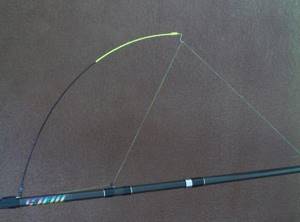
Step-by-step instruction
Let's start assembling our alarm device.
- We make a hole at the end of the tube or rod according to the diameter of the wire.
- We bend the wire in an arc, measure 5 cm from one end and bend it 90 degrees outward from the inner bend of the arc.
- We thread the wire through the hole in the tube or rod. We will have a curved tip parallel to the guide.
- We coat the tip of the wire and the guide with glue and wrap it tightly with thread in several layers.
- We coat each layer with glue.
- Once it dries, you can either paint this place or open it with varnish (for example, for nails), as an option, put a heat-shrinkable tube over the gluing area and use a lighter to encircle it along the diameter.
- At the other end we bend the hook for winding the main fishing line.
- We insert the guide into the pipe holder (it is better to place it on glue).
- We paint with “poisonous” paint or cover with a bright film 5–7 centimeters of the tip of the holder on the side of the fishing line hook.
- We put it on the rod handle after the reel. The arc wire should be on the side.
- We grab the ends of the holder with a thick rubber band (so as not to fly off). We hook the main line after the reel to the hook on the wire arc.
When biting, the line tightens and bends in an arc. Based on the vibrations of the bright tip of the arc, it is easy to determine the moment of the bite.
Do-it-yourself bite alarms - how to make sound, electronic, lateral and visual
This article will present the types of bite alarms, their brief characteristics, advantages and disadvantages, as well as DIY options.
The alarm is an indispensable part of fishing gear, the main purpose of which is to improve the quality of fish bite and its timely recognition.
There are:
- visual;
- sound;
- lateral;
- electronic.
Visual alarms
The basis of the work is monitoring the progress of the bite. This type of gear makes it more obvious, saves time and bait.
These include:
- nod;
- float;
- foil tube;
- Firefly.
Nod
The nod is an inexpensive device, attached to the tip of the feeder, it happens:
- Lavsan , the same (polyethylene terephthalate) PET, the material of a plastic bottle. A lavsan nod is great for fishing with a jig, especially if with a bloodworm, in which case the jig plays better. The length of the nod should be 10-15 cm. Such a nod can be made at home by cutting it out from the same bottle and making a hole using a heated needle.
- A metal nod made of stainless steel is best suited at depths or currents, which makes it possible to perfectly distinguish between a fish bite and a current jerk, and it can be bent to improve the appearance of the bite. Its length is up to 18 cm. It consists of a metal plate 1.5-3 mm wide, the fastening should be a cone for free adjustment of the plate stroke, and at the end there is a plastic ring for the passage of fishing line. For the entire length of the nod, you need to install 1-2 cambrics to hold the fishing line. You can make it at home using a hard rubber band for a cone, plate, cambric, and ring.
- Spring nod , an excellent bite indicator in the case of heavy baits, especially for predatory fish. Used for fishing methods such as using a spinner or spinners. You can make it at home using a twisted spring 15-18 cm long, 2-3.5 mm in diameter, a rubber or plastic fastener and large beads with a hole for the fishing line to pass through.
- Balanced nod , works thanks to the principle of counterweight. A moving weight is attached to the end of the nod, which balances the mass of the tackle. Equipped with bearing. Perfect for winter fishing in a tent.
The upper nod - the bite alarm is made of dense foam. On the bottom - made of polyethylene foam
Manufacturing procedure:
- You will need a copper wire on which the sliding element will be located and rotate , and its upper part will prevent the nod from rotating around its axis.
- In order for the glide to be perfect and fit the size of the wire , you need to cut off a piece of the ear stick and secure it.
- The working part of the nod itself can be taken from old non-working metal nods.
- The balancing weight - lead or tin , moves along the nod, is fixed with cambrics and is selected according to the weight of the equipment.
Float
Fishing gear that does not require special financial costs. To make it, you need to take into account the depth of the reservoir, casting distance, and current speed. The choice of material and method of processing the float will depend on this.
When purchasing or making a float, consider the following:
- A heavy float weighing 3-10 grams is designed for casting a fishing rod at least 50 m ; it is designed for larger fish: a nice catfish or carp.
- A medium-heavy float weighing 0.8-2.5 grams will be needed on bodies of water with a current. This tackle is perfect for large crucian carp or silver carp.
- A light float weighing up to 0.8 grams is used for catching fish near the shore. Very sensitive and responds even to a barely noticeable bite. Used for catching roach, rudd, sebel, crucian carp.
Let's consider options for making light floats at home; they will cost pennies, and they can be made in a matter of minutes.
To make it you will need:
- Styrofoam;
- wine stopper;
- goose or duck feather;
- cane.
Additional materials include: colored acrylic paints, waterproof glue, wire, toothpicks of different lengths.
Tools you will need: drill, sandpaper, sharp knife, drill (diameter 2 mm).
Varieties:
- Foam float. A cylindrical piece 5 cm long and 2 cm thick is cut out of dense foam plastic. Next, a long toothpick is inserted into this workpiece, and its other end is inserted into the drill chuck, which is tightly secured in a vice. While the drill rotates the workpiece, you need to sand it using sandpaper and give it the desired shape. Then the toothpick is removed and a new one is inserted, having previously been “planted” on the glue to a depth of 2/3 the size of the float. The polystyrene foam is painted with bright paint; you can use nail polish. To attach the float to the fishing line, a swivel carabiner is attached to its lower part. The process for making a float from a wine cork is identical; moreover, the cork does not need to be sanded, but simply covered with several layers of paint.
- Duck or goose feather float. The feather is first cleaned of fluff using a sharp knife and held over low heat to remove excess fluff. Since the length of the feather can be different, the float will need no more than 15 cm. We paint it in a bright “poisonous” color, attach two rubber rings in the middle and at the bottom of the float and attach it to the fishing line.
- A reed float is made in the same way as a feather float, and besides, you can make it right while fishing, just taking nail polish with you.
Foil tubes
Cheap and easy. It works by oscillating the line. Done in 5 minutes.
How to make at home:
The material used is aluminum foil and rolled into a tube. Slides onto the main line. It is important to thread the line between the first ring on the feeder and the reel to create slack in the line.
The first ring of the feeder should be thicker than the tube itself. When biting, the sag of the fishing line will decrease. Foil “plays” well in the sun and rustles, but due to its lightness it is useless in the wind.
fireflies
Excellent tackle for night fishing. Thanks to the fluorescent glow, it is clearly visible in the dark. Used with spinning rods, fishing rods, and other gear.
How to do it yourself? There are several options worth considering:
- Take white or yellow foil and cut it into strips about 5 mm wide. Apply the finished strips to the float antenna using waterproof glue. To check it in action, you should shine a little light, you can take a flashlight.
- Purchase specialized phosphorus-rich paint that can glow in the dark and apply it to the float.
- To make it you need to take: a stationery clip, a clothespin, a fishing firefly.
A firefly is attached to the clamp and placed on the top of the feeder. It is recommended to put it on before each cast so as not to damage the rod.
The big advantage of all types of visual alarms is their more than reasonable price and ease of use. Well, the downside is that in difficult weather conditions (wind, rain, strong currents) their effectiveness is practically zero.
Fireflies – thanks to the fluorescent glow, they are clearly visible in the dark
Sound alarm
The simplest are a bell or a rattle. The bell is often used at long distances on a spinning fishing rod.
Principle of operation
A set of fasteners in which, for example, a bell is attached to the top of a feeder. If it starts to peck, the top of the feeder, on which the alarm is attached, begins to oscillate and our device produces a sound.
The advantages include low cost, sensitivity to the slightest bites, and the ability to use over long distances.
Step-by-step manufacturing instructions
Would need:
- A flat spring about 20 cm long , you can take it from an old alarm clock or watch. It should be smooth, without errors.
- Aluminum wire 20 cm long.
- Plastic strip 20 cm long.
- Dye.
We make holes with different diameters on the sides of our spring. We fasten the plastic strip on one side with wire so that it holds securely against the passage ring. On the other side we make a hook that holds the spring.
Sound bite alarm
Side warning light
Or, as experts say, lateral quivertype. The device is based on a fastening to the feeder form and a springy part made of plastic or metal. Placed between the coil and the first ring of the feeder.
How does it work
After casting, the line is threaded into the hook, which is located at the end opposite from the feeder. The length of the chassis is about 10-15 cm. We place the side quivertip to the feeder form at an angle of 90 degrees. When the bite starts, the device will become almost parallel to the feeder.
Important advantages are:
- works in any weather conditions;
- Suitable for use on the winding banks of reservoirs, where there are many cliffs and snags.
Since the bulk of quivertypes are made of fiberglass, the big disadvantage is its excessive softness, which means that in the case of a strong current its sensitivity is lost. Also, this material, even under light loads, can begin to delaminate.
How to make a quivertype
To make a quivertype at home you will need:
- 15-20 cm of metal spring wire;
- metal tube with a diameter of 2 mm and a length of 5 cm.
At a distance of 15 cm from the coil, we fix the tube on the feeder form. Next, we make a Z-shaped hook at one end of the wire, and bend the other at a right angle for fastening in the tube. We place the finished product on the feeder and throw it out. We insert the fishing line into the quiver tip hook. For better visibility, attach a bright colored ball to the end of the hook.
Side bite alarm for feeder
How to do it yourself
To make it cheaper and more efficient, you need to use the most ordinary keychain with sound as a basis. The contacts of the key fob, preferably in the form of two plates, should be removed outside.
We close the key fob button and attach it to the fishing rod stand. We take a piece of plastic (strip) 2 mm thick and attach it to the fishing rod between the first ring and the reel and bring it out between the contacts. As soon as it starts to bite, the line will pull out the plastic, a short circuit will occur and the music will start playing.
Blitz tips
- When purchasing an electronic alarm, pay attention to what the components are made of. Don’t be too price-conscious; plastic alarms are inexpensive, but they won’t last long.
- When transporting gear, do not forget to pack the alarm in a special case in order to avoid cracks and breakages.
- To make the bell more sensitive , the spring to which it is attached must be stretched as much as possible.
- You should not buy alarms with a metal keel. Such a float does not reflect bites well and determines depth.
- If in sunny weather the fish does not want to bite , then you need to make the alarm darker and attract the fish to the newly fed place.
Source: https://lakeking.ru/snasti/gadjet/signalizator/svoimi-rukami.html
Schemes of simple electronic bite alarms (working principle)
Option 1. Simple circuit of an electronic signaling device
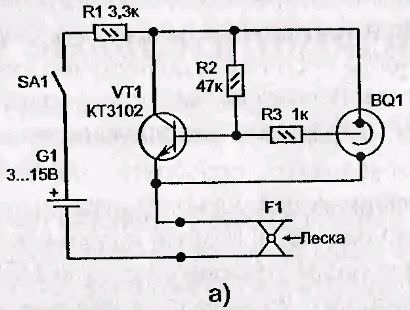
The line tension sensor is made from a contact group from the RPU-2 relay. It is only important to set the relay to open at the slightest movement of the fishing line, but this can be done very easily during assembly.
Option 2. Simple circuit of a waiting sound and light alarm
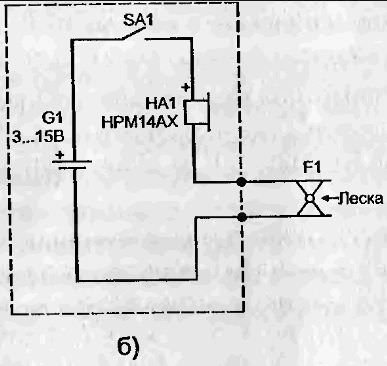
A very simple scheme. The sensor is based on the same RPU-2 relay or any other analogue. The fishing line is wound behind the sensor and connector SA1 is closed manually. As soon as the line is tensioned during a bite, it will pass through the sensor and the chain will allow the speaker to signal the bite. You can also install an LED in parallel for light signaling. Read the article about fireflies for night fishing with a battery.
Option 3. Electronic alarm from a key fob with a melody
A very simple scheme and does not require additional description. The RPU-2 relay or its equivalent is still used.
Option 4. A more complex circuit of a waiting bite alarm
To assemble an electronic signaling device, you need to have at least minimal design skills - what housing to place, what system is best to come up with, mounting method, etc. Each designer determines this for himself. We will tell you about the very principle of operation of the electronic signaling device and its components. For assembly you will need:
- 3 volt battery (or several connected in series).
- Contacts from a broken alarm clock or toy.
- The reed switch is open, without a magnet.
- Magnet (can be used from a furniture latch).
- LED or buzzer (or both for a combination alarm).

Here is the most complete circuit of an electronic sound signaling device.
The principle of operation of such a signaling device is as follows: when a magnet is supplied to the reed switch (during a bite), the circuit closes and transmits electric current to the LED or tweeter (or to both elements). The LED lights up or the beeper buzzes, signaling the start of a bite.
Such a circuit can be used, for example, in the mechanical signaling device described above - improving it into an electronic, combined one. In this case, we need to bend the arc so that it is closer to the rod with the tip where the hook is located, through which the main line passes. You need to attach a magnet to this tip of the arc, and attach the batteries, a reed switch and an LED with a buzzer located inside some tube or box to the rod.
How to make a spring for fishing on a feeder - the technology for creating a pseudo-method feeder.
A detailed carp guide for beginning carp anglers. Construction of basic gear and many other aspects.
Bait for wild carp at this link.
When biting, the fishing line will stretch and bend the wire arc with the magnet, bringing it closer to the reed switch. The reed switch will close the circuit and supply power to the LED and buzzer. You can put a toggle switch in the circuit to turn the tweeter on and off at will, and then it will only work in the on position.
To ensure that the LED always works, install the toggle switch in the circuit after the LED, so that the LED itself is not left without power in the off position. It turns out to be a wonderful signaling device.
The easiest way to make a bite alarm with your own hands - Website about
Most fishermen use bottom gear, which is distinguished by its catchability and simple design. But to use donks effectively, alarms are needed.
Even with self-hooking rigs, the angler must respond to a bite in time and carefully bring the fish into the landing net. On feeder rods, the guard is a flexible whip - a quivertip, the bending and vibrations of which indicate a fish bite.
When fishing with other bottom gear, the following alarms are needed:
- sound;
- visual;
- combined type.
Electronic alarms provide both audio and visual registration. When a fish bites, electronic donkey alarms emit a sound signal and the lights on them light up, creating a visual effect.
How does a bite alarm work?
The principle of operation of the donkey guard is based on the fact that at the moment of a bite, the fishing line transmits vibrations of the equipment, recorded by a signaling device. The fish, having grabbed the bait, moves in any direction. The donkey alarm responds to fishing line pulls, regardless of their strength.
A powerful jerk is much more noticeable - it can be recorded by both a factory and a homemade device. Large fish often bite cautiously, and it is important for the alarm to be sensitive in order to detect such a bite.
Requirements for signaling devices for donkey:
- high sensitivity;
- simplicity of design;
- protection from water;
- reasonable price.
Each angler chooses bite indicator devices depending on:
- fishing conditions;
- own needs;
- weather conditions;
- expected fish in the catch;
- time of day.
At night, visual indicators are ineffective, even with lighting. It is impossible to sit for several hours without taking your eyes off the rod, and if you are distracted, you will miss the bite. Therefore, at night, sound sensors are needed for donkeys. And if they also provide a visual effect, the return on such equipment increases significantly.
The weight of the transducer is important, and this concerns not only the convenience of the angler. In strong winds, a lightweight design will show false bites, and the meaning of the device itself is tripled.
Buying a signaling device is not difficult; stores sell models for both summer and winter fishing. But quality equipment doesn't come cheap. Therefore, many fishermen prefer to make sensors themselves from scrap materials; it is cheaper and takes a little time.
DIY bite alarm
The most common homemade donkey gatehouses are:
- pendulum type;
- nod type.
A homemade universal signaling device for donkey is mounted on a fishing line and attached to the rod rings. When a fish bites, the tackle, which is in a tense state, changes its position in the water, and the fishing line moves, transmitting vibrations to the guard.
The advantage of such a signaling device is that it is attached to the rod and remains hanging on its ring when hooking. However, the fisherman needs to monitor the bottom tackle with a hand-made pendulum sensor for the bottom in order to make a hook in time.
The easiest way
To make the simplest pendulum tracking sensor for a donkey you will need:
- a piece of aluminum or copper wire 20−25 cm long;
- 2 cambrics with a diameter slightly larger than the diameter of the wire section;
- lead weight with a ring;
- pliers.
The procedure for making a homemade tracking sensor for a donkey:
- put the weight on the wire and fix it in the middle by twisting the wire into a ring;
- put cambrics on the wire;
- bend the ends of the wire into rings and secure them with cambrics.
Mounting on the bottom:
- move the cambric and hook the wire ring to the lower ring of the rod;
- secure the gatehouse with cambric;
- move the second cambric and put the ring on the fishing line;
- secure the ring with cambric.
Due to the weight, the homemade signaling device will tighten the fishing line, and when there is a bite, transmit a signal about this, moving in the vertical direction.
After fishing, the bite indicator is removed from the fishing line and stored in the tackle box. It will take 5-7 minutes to make such a device; it is easy to transport and use.
Pendulum signaling device
Homemade pendulum alarms are attached to the tensioned line of the fishing rod and, when biting, make movements similar to the movements of a pendulum.
The simplest pendulum guard consists of:
- bell;
- rubber stopper or rectangular piece of foam rubber.
To make such a device you need:
- cut a piece of rubber in the shape of a parallelepiped, measuring 5x2x1 cm;
- insert a bell ring from the end of the rubber and secure it with wire or thread;
- At the opposite end of the rubber, make a cut with a blade to fix the sensor on the fishing line of the fishing rod.
After casting the tackle, the rod is placed on a stand, and the guard is attached to the fishing line below the last ring of the rod. Due to the weight of the indicator, tension is created in the fishing line; when biting, it begins to move in a horizontal plane, warning the fisherman about the need to hook.
After hooking, the alarm flies off the line, without creating problems when landing the caught fish. In order not to look for a flying guard in the grass, a piece of thin rope or fishing line is attached to the elastic band, the other end of which clings to the rod stand.
Kinder bite alarm
The simplest wire donkey alarm can be improved with the help of a plastic case from a Kinder Surprise toy. It needs to be secured to a fishing line instead of a lead weight, which will make it possible to adjust the weight of the weighting agent.
In strong winds, pendulum alarms for donkeys turn out to be ineffective due to false alarms. It is necessary to make the load heavier, and to do this, additional lead weights are placed in the body of the Kinder Surprise.
A lightweight sensor is more sensitive, but if the weather demands it, it is better to make the structure heavier to provide the necessary comfort.
In order for the alarm for the Kinder Surprise donkey to be triggered when a fish bites towards the shore, you need to tighten the main line more strongly and put a load of at least 20 grams.
Electronic alarm
Electronic indicators for donkeys have serious advantages over other similar accessories:
- are highly sensitive;
- do not register false bites;
- fix bites towards the shore;
- allow the fisherman to take his mind off the gear;
- Easily mounted on stands or rod pods.
The high cost of electronic devices for donkeys quickly pays off with active use. Nowadays, Chinese-made electronic devices with attachment directly to the fishing rod have appeared in stores.
To install such a sensor on the tackle, you do not need a rod or stand; it is fixed on the form and does not require any additional devices. An electronic device can be made independently by those who know how to hold a soldering iron in their hands and are able to distinguish a resistor from a microcircuit.
For this you need:
- small plastic alarm clock;
- resistor;
- a piece of rigid steel wire 25-30 cm.
Manufacturing procedure:
- the extreme contacts of the resistor are soldered together;
- the middle contact of the resistor is attached with a wire to the alarm clock board;
- the resistor is attached to the alarm clock body with glue;
- Using an awl, holes are made in the housing opposite the resistor hole;
- A nod with a curved tip is made from wire to attach the fishing line;
- a wire nod is rigidly attached to the hole in the housing (resistor).
Such a device is attached to the rod blank with adhesive tape, the tackle is cast, and the whip is installed on the stand. The line should be taut, the nod should be fixed on it, and the guard is ready for use.
Electronic signaling device Megatext and its operating principle
You can read a detailed article about it here. Suitable for ice and summer fishing with bottom gear.
The advantage of this design is that in the open state our alarm does not consume power from the elements at all. It can be used at any time of the day. If you need to move away, you just need to turn on the buzzer and it will notify you of a bite at a distance from the rod. In case of failure or discharge of the batteries, such a detector will be able to operate in mechanical mode. It will be enough to remove the magnet and bend the arc to its old position. Successful hooks to you.

